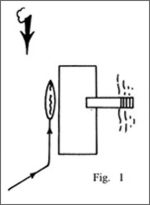Docking Under Sail
Sailtips from the Offshore Sailing School
 There are times when you must dock under sail, either because your boat doesn't have an engine or because the engine is inoperable for some reason or other. The process isn't much different from sailing up to a mooring. The boat must be headed into the wind to stop. Each approach depends on the wind direction. If the wind is blowing parallel to the dock (as in Figure 1), just shoot the boat into the wind and come to a stop alongside the dock. If the wind is blowing away from the dock toward open water (as in Figure 2), there are two options: (1) use the end of the dock and shoot straight into the wind, or (2) shoot at an angle into the wind and luff the sails to slow the boat down. Then come parallel to the dock at the last minute.
There are times when you must dock under sail, either because your boat doesn't have an engine or because the engine is inoperable for some reason or other. The process isn't much different from sailing up to a mooring. The boat must be headed into the wind to stop. Each approach depends on the wind direction. If the wind is blowing parallel to the dock (as in Figure 1), just shoot the boat into the wind and come to a stop alongside the dock. If the wind is blowing away from the dock toward open water (as in Figure 2), there are two options: (1) use the end of the dock and shoot straight into the wind, or (2) shoot at an angle into the wind and luff the sails to slow the boat down. Then come parallel to the dock at the last minute.
Remember that if the boat is sailing slowly, as soon as you turn the boat broadside to the wind it will start going sideways (making leeway), so get the bow and stern lines to the dock as fast as possible and walk the boat along the dock as it slows down. When the wind is blowing toward the dock from the open water, docking is more difficult. The best approach is without any sails raised if the wind is heavy, or with only the jib if the wind is light. Round into the wind (as in Figure 3) and lower the sails. Then drift into the dock. You'll be surprised how well many boats can sail without any sails up. Many can sail practically on a beam reach without any sail once they have picked up some speed.
When the wind is blowing toward the dock from the open water, docking is more difficult. The best approach is without any sails raised if the wind is heavy, or with only the jib if the wind is light. Round into the wind (as in Figure 3) and lower the sails. Then drift into the dock. You'll be surprised how well many boats can sail without any sails up. Many can sail practically on a beam reach without any sail once they have picked up some speed.
Not all landings are perfect and a crew member may have to toss a docking line to someone ashore to keep the boat under control until finally secured. The line he/she intends to toss should have one end previously attached to the boat so that the whole line doesn't accidentally get thrown to the dock. The dock lines needed will be the bow and stern lines, and the "forward spring" line, which leads from a cleat on the dock to a fitting forward on the boat to keep the boat from moving forward. The "after spring" leads from the dock to a fitting near the stern to keep the boat from moving aft. Now properly secured, the boat will rest on the fenders provided and will not rub her topsides on dock or pilings.
The dock lines needed will be the bow and stern lines, and the "forward spring" line, which leads from a cleat on the dock to a fitting forward on the boat to keep the boat from moving forward. The "after spring" leads from the dock to a fitting near the stern to keep the boat from moving aft. Now properly secured, the boat will rest on the fenders provided and will not rub her topsides on dock or pilings.
Reprinted from "Fundamentals of Sailing, Cruising, & Racing"
by Steve Colgate; published by W.W. Norton & Co.
Steve Colgate is the founder of Colgate Sailing Schools, with locations in Tortola BVI, Captiva Island FL, Duck Key FL, St. Petersburg FL, Chelsea Piers NY, Liberty Landing NJU and Newport RI.
Offshore Sailing Schools
16731 McGregor Blvd.
Fort Myers, Florida 33908
1-888-454-8002
239-454-1700
Fax: 239-454-1191
e-mail: [email protected]
www.offshore-sailing.com












